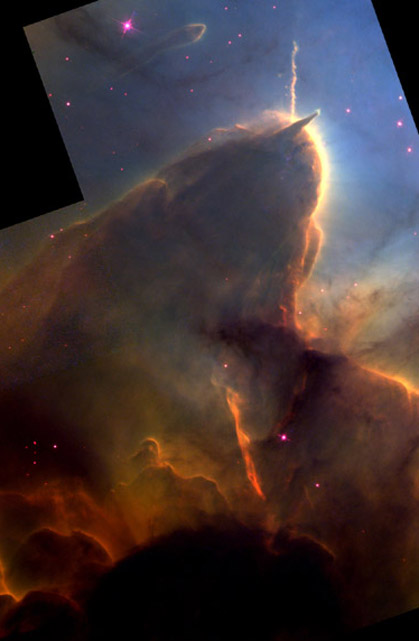
[back] M 20 (Trifid Nebula) in Sagittarius [NED]
Click here for image with "normal" width / Hier klicken für Bild mit "normaler" Breite

|
(c) 2004 All astro photo images are copyrighted. They may not be used |
|
2' |
|
or reproduced without explicit written permission from the authors. |
|
|
The image of the Trifid Nebula is a twofold
mosaic. To get an overall impression, the result was highly scaled down.
Here you
can find a version of the image with the resolution common to the other images
of this web site. A well known exposure of a part of M20 was done by the HST in
1999. This famous false color composite is displayed below left (a higher
resolution can be found
here), right to it the corresponding section of the image above in the
original resolution (1 pixel = 0.3"). Taking into account, that the HST image is
resolved much higher in its original version, it becomes obvious, how big the
difference in sharpness is between earth bound images and those of the HST.
Nevertheless it may be interesting to compare the results.
Die Aufnahme des Trifidnebels entstand als Zweifachmosaik. Um
einen Gesamteindruck "auf einen Blick" zu erhalten, wurde das Ergebnis oben
stark verkleinert. Das Bild mit der für diese Web-Site üblichen Breite finden
Sie hier.
Eine sehr bekannte Aufnahme eines Teils von M20 wurde vom Weltraumteleskop
Hubble im Jahre 1999 gemacht. Diese berühmte Falschfarben-Aufnahme sehen Sie
unten (eine hoch aufgelöste Version ist
hier zu finden), rechts davon der entsprechende Ausschnitt der Aufnahme oben
in Original-Auflösung (1 Pixel = 0,3"). Wenn man bedenkt, dass das HST-Bild im
Original viel höher als hier dargestellt aufgelöst ist, wird einem klar, wie
weit die Schärfe erdgebundener Aufnahmen von denen des Hubble entfernt ist.
Trotzdem ist es immer wieder reizvoll, die Ergebnisse miteinander zu
vergleichen.
|
(c) 2004 All astro photo images are copyrighted. They may not be used or reproduced without explicit written permission from the authors. |
 |
About this Image / Über dieses Bild
| CCD: | ST10 XME |
| Image Type, Orientation: | L-HaOIIIB Composite, 1x2 Mosaic, North is at 1:30 |
| Exposure time: | for each of the two images: L: 16x60 sec., Ha,OIII: 8x120 sec., B: 4x120 sec., all 1x1 bin |
| Exposure date: | June 18th, 2004 |
| Location: | Capella Observatory at Amani Lodge, Kupferberg near Windhoek, Namibia |
| Filter: | FR03 + Astronomik Typ II L,Ha,OIII,B filters |
| Instrument: | Ganymed 60cm-Hypergraph in secondary focus, f=4800 mm |
| Image seeing (FWHM): | 1.7"-2.0" |
| Photographer: | Josef Pöpsel, Beate Behle |
| Remarks: |
The two parts of the mosaic were generated by using the
brightest star of the upper half as the guide star for the lower half and
vice versa. In between the camera was turned around 180° as precise as
possible. Beate as co-author of this image wants to emphasize, that she is
always impressed by the "horns" shown above as it is remarkable, how many "earthly"
things can be seen at the firmament. The image was processed with CCDSharp;
DDP was selectively used for the brightest stars of the lower part. 20 years after this image a new version of M20 was done im primary focus from Crete/Grece. The new version, done with the same telescope can be found here. It clearly shows the enhancements in camera hardware and image editing developed during 20 years... |
|
|
|
| Bemerkungen: | Die beiden Teile des Mosaiks entstanden, indem für den
unteren Teil der hellste Stern des oberen Teils und für den oberen Teil der
hellste Stern des unteren als Leitstern verwendet wurde. Zwischendurch wurde
die Kamera möglichst genau um 180° gedreht. Beate als Koautorin des Bildes
legt besonderen Wert darauf, zu erwähnen, dass sie immer wieder beeindruckt
von den "Hörnern" in der Detailaufnahme ist, wie es überhaupt bemerkenswert
ist, wie viele "irdische" Dinge am Firmament zu sehen sind. Für die Aufnahme
wurde CCDSharp und selektiv DDP im Bereich der hellsten Sterne unten im Bild
benutzt. 20 Jahre nach diesem Bild entstand auf Kreta/Grichenland eine neue Version von M20 im Primärfokus. Diese neue Version, mit dem selben Teleskop gemacht, ist hier zu finden. Sie zeigt deutlich die Weiterentwicklung im Breich Kamera-Hardware und Bildbearbeitung inerhalb von 20 Jahren... |
Back to the Diffuse Nebulae Overview / Zurück zur Diffuse-Nebel-Übersichtsseite